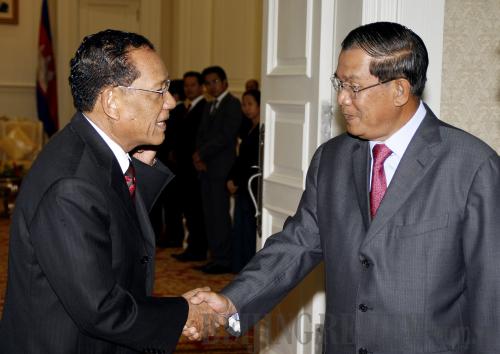|
 |
|
PEACE EFFORT: Cambodian Prime Minister Hun Sen (right) greets visiting Thai Deputy Prime Minister Trairong Suwannakhiri in Phnom Penh on February 17 (XINHUA) |
Cambodia-Thailand relations have recently become tense again. Their border dispute in February claimed at least 11 lives and injured close to 100. Large numbers of villagers on either side of the border were forced to leave their homes and move to makeshift camps.
Origins
The core of the dispute is the Preah Vihear Temple located on the Cambodia-Thailand border. The dispute can be traced back to ancient times. Originally built by Cambodians in the ninth century, the temple became important during the reign of two Cambodian kings from 1010 to 1150. As devout Buddhists, the kings enlarged the temple and made it a sacred place. Most of the surviving structures at the temple date back to that period.
Invading Thai forces took over the Preah Vihear Temple in the early 15th century. However, Cambodians continued to view the temple as their spiritual home. Since then, seeds of hostility have remained in the hearts of the two nations. Both Cambodia and Thailand claim sovereignty over the temple and its neighboring areas. Disputes have broken out from time to time.
The current Cambodia-Thailand border is based on a map drawn by French colonists. In 1887, Cambodia became a French colony. In 1907, France unilaterally placed the temple under Cambodian administration. In 1953, Cambodia gained independence. After French withdrawal from Cambodia, Thailand assumed control over the temple. Cambodia urged Thailand to return the temple, and took the matter to the International Court of Justice in the Hague.
In 1962, the International Court of Justice ruled the temple belonged to Cambodia, but sovereignty over land near the temple remained controversial. Thailand refused to accept the ruling, claiming the temple's main entrance is on the Thai side. In addition, the many landmines buried around the temple during previous conflicts hindered the progress of border demarcation. Therefore, the ruling was never enforced.
In 2008, UNESCO approved Cambodia's application to have the temple listed as a world heritage site. The decision reignited tension between the two countries. Previously, large-scale conflicts broke out in October 2008, April 2009 and January 2010.
Clashes
The 2011 clash actually began at the end of last year. On December 29, 2010, seven Thais were arrested by Cambodian soldiers in a disputed border area. Five of them were charged with illegal entry and illegally entering a military base along the border. By February, they had been released on bail. But the other two—Veera Somkwamkid, a leader of Thailand's People's Alliance for Democracy (Yellow Shirts) and his secretary—were sentenced to eight and six years in jail, respectively, for illegal entry, illegally entering a military base along the border and espionage.
Hearing the news, Yellow Shirts launched a rally of more than 1,000 people in Bangkok. They surrounded the Government House, requesting the government withdraw from the World Heritage Convention and cancel the memorandum of understanding regarding the Thailand-Cambodia border signed in 2000. They also requested expelling all Cambodian soldiers from disputed areas.
In the meantime, Thailand found Cambodia's flag at a pagoda in the Preah Vihear Temple and a stone tablet, saying that was the place where Thai troops invaded Cambodian territory. Faced with fierce Thai protests, Cambodia got rid of the stone tablet, but refused to remove the flag. Instead, it placed another stone tablet at the pagoda, reading: "Here is Cambodia."
| 